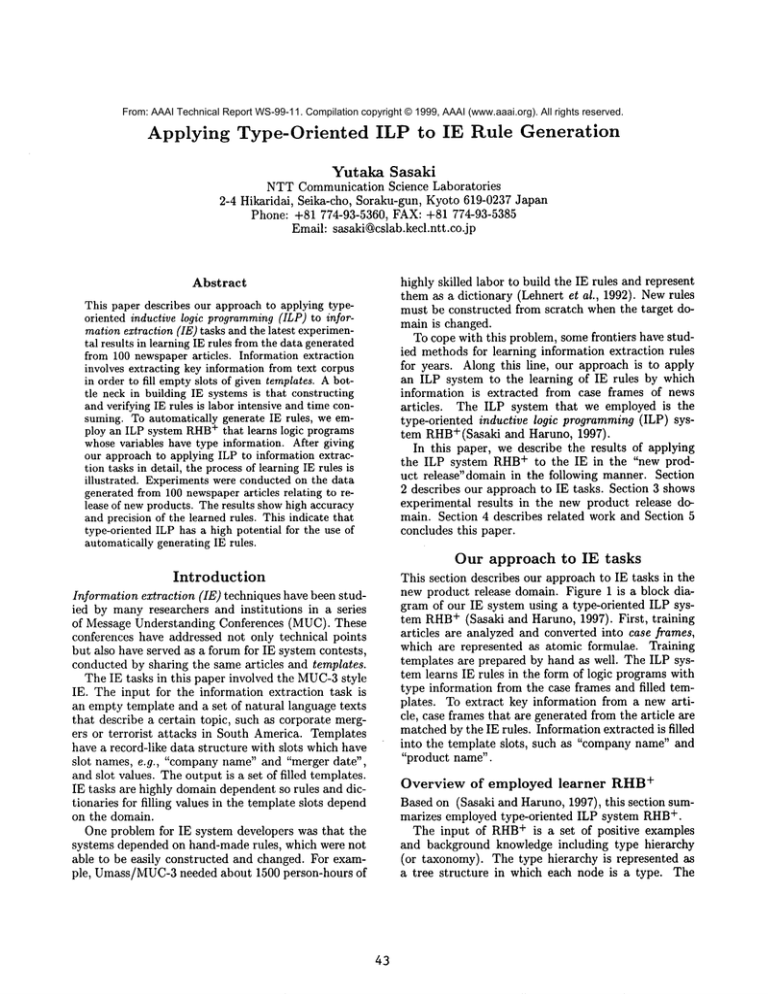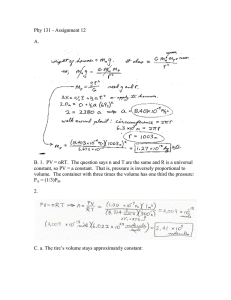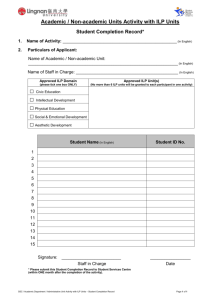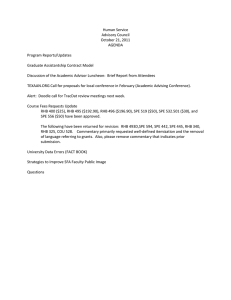
From: AAAI Technical Report WS-99-11. Compilation copyright © 1999, AAAI (www.aaai.org). All rights reserved.
Applying
Type-Oriented
ILP to IE Rule Generation
Yutaka Sasaki
NTT Communication Science Laboratories
2-4 Hikaridai, Seika-cho, Soraku-gun, Kyoto 619-0237 Japan
Phone: +81 774-93-5360, FAX: +81 774-93-5385
Emaihsasaki@cslab.kecl.ntt.co.j p
highly skilled labor to build the IE rules and represent
them as a dictionary (Lehnert ctal., 1992). Newrules
must be constructed from scratch when the target domain is changed.
To cope with this problem, somefrontiers have studied methods for learning information extraction rules
for years. Along this line, our approach is to apply
an ILP system to the learning of IE rules by which
information is extracted from case frames of news
articles.
The ILP system that we employed is the
type-oriented inductive logic programming(ILP) system RHB+(Sasaki and Haruno, 1997).
In this paper, we describe the results of applying
+ to the IE in the "new prodthe ILP system RHB
uct release’domain in the following manner. Section
2 describes our approach to IE tasks. Section 3 shows
experimental results in the new product release domain. Section 4 describes related work and Section 5
concludes this paper.
Abstract
This paper describes our approach to applying typeoriented inductive logic programming
(ILP) to informationextraction (IE) tasks and the latest experimental results in learning IE rules from the data generated
from 100 newspaperarticles. Information extraction
involves extracting key information from text corpus
in order to fill emptyslots of given templates. A bottle neck in building IE systems is that constructing
and verifying IE rules is labor intensive and time consuming. To automatically generate IE rules, we em+ that learns logic programs
ploy an ILP system RHB
whose variables have type information. After giving
our approach to applying ILP to information extraction tasks in detail, the processof learning IE rules is
illustrated. Experiments were conducted on the data
generated from 100 newspaperarticles relating to release of newproducts. The results showhigh accuracy
and precision of the learned rules. This indicate that
type-oriented ILP has a high potential for the use of
automatically generating IE rules.
Our approach
to IE tasks
This section describes our approach to IE tasks in the
new product release domain. Figure 1 is a block diagram of our IE system using a type-oriented ILP sys+ (Sasaki and Haruno, 1997). First, training
tem RHB
articles are analyzed and converted into case frames,
which are represented as atomic formulae. Training
templates are prepared by hand as well. The ILP system learns IE rules in the form of logic programs with
type information from the case frames and filled templates. To extract key information from a new article, case frames that are generated from the article are
matchedby the IE rules. Information extracted is filled
into the template slots, such as "companyname" and
"product name".
Introduction
Information extraction (IE) techniques have been studied by many researchers and institutions in a series
of Message Understanding Conferences (MUC). These
conferences have addressed not only technical points
but also have served as a forum for IE system contests,
conducted by sharing the same articles and templates.
The IE tasks in this paper involved the MUC-3
style
IE. The input for the information extraction task is
an empty template and a set of natural language texts
that describe a certain topic, such as corporate mergers or terrorist attacks in South America. Templates
have a record-like data structure with slots which have
slot names, e.g., "company name" and "merger date",
and slot values. The output is a set of filled templates.
IE tasks are highly domain dependent so rules and dictionaries for filling values in the template slots depend
on the domain.
One problem for IE system developers was that the
systems depended on hand-made rules, which were not
able to be easily constructed and changed. For example, Umass/MUC-3needed about 1500 person-hours of
Overview
+
of employed
learner
RHB
Based on (Sasaki and Haruno, 1997), this section sum+.
marizes employed type-oriented ILP system RHB
+ is a set of positive examples
The input of RHB
and background knowledge including type hierarchy
(or taxonomy). The type hierarchy is represented
a tree structure in which each node is a type. The
43
new article
case frames
Ana yse ,I
I---- I
II
articles sentences
I release(cl,pl)
II II
L J--
[---J
,~."~r-"
~ a°.ouncs(cl,d)[J_~
’
IErules
!~."’’~
................
~~
~
I "
~ sy~tern ~
:0- I
II llll
................
Answer
ilY
template~
fi,ed
by hand
. . I
-" l
A;n
l :esl
@ case frames
IT
I
,I ,,r,.o,.,no,,(c2,~)ll
v
~/,
.......
~
!
~,~pI~,ruIes
I_
8°;.~’%,°~o
Product: printer ~ to the case
I
~.., frames
Figure 1: Block diagram of IE using ILP
direct links between the nodes represent is_a relations
and the root of the tree, described as T, is the most
general type. The output is a set of clauses having
variable with type information.
+ has two features indispensable to the learner
RHB
for IE tasks: (1) it learns logic programs based on
terms; (2) learns from only positive examples. T-terms
are the restricted form of C-terms used in LOGIN
(A~tKaci and Nasr, 1986) and LIFE (Ai’t-Kaci et al., 1994).
Informally, ~--terms are Prolog terms whose variables
are replaced with variable Var of type T, which is denoted as Var:T. For example, a learned hypothesis can
be
returns U:u where u is the least upper bound of t and
s according to the type hierarchy if t and s are types,
otherwise it returns V:T with a new variable V. For a
concice definition, we use the operator prime (’) which
is defined as (X:s)’=s, and g = t if t is a constant,
type or function with no variable attached.
Definition 2 lgg of terms with types
1. lgg(t,t) =
2. lgg(f(ll ~ Sl,..,l,
~ s,),f(ll
~ tl,..,ln
t. ) =
f(ll ~ lgg(sl, tl), ..., in ~ lgg(sn, t,)).
3. lgg(s, t) = u for term s and t of different symbols
or with different function names, where the tuple
(s, t, u) is in the history
4. lgg(s, t) = u for term s and t of different symbols
with different function names, where u = lub(s’, g)
and (s, t, u) is not in H. Then add (s, t, u) into
speak(X:human, Y:language)
grew_in(X,Z:country), officiaLlang(Z,
Moreover, a function is allowed to have labels or keywords for readability. A combination of bottom-up and
top-down approaches is employed, following the result
described in (Zelle et al., 1994).
Algorithm
+ finds covers of the given posThe outer loop of RHB
itive examples P in a greedy manner. It constructs
clauses one by one by calling inner l.oop( P, Po, BK)
which returns a hypothesis clause, where Po is original
positive examples and BK is background knowledge.
Covered examples are removed from P in each cycle;
P0 remains unchanged. Algorithm 1 shows the algorithm of the inner loop.
+ is the dynamic type reThe special feature of RHB
striction by positive examples during clause construction. The restriction uses positive examples currently
covered in order to determine appropriate types. For
+ comeach variable Xi appearing in the clause, RHB
putes the lub of all types bound to Xi when covered
positive examples are unified with the current head in
turn.
The search heuristic PWIis weighted informativity
employing the Laplace estimate (Cestnik, 1990). Let
T = {Head :-Body } U BK.
r-term
Formally, terms of a Horn clause (Lloyd, 1987) were
extended to terms with types, called v-terms.
Definition 1 (v-terms)
1. An individual constant is a T-term.
2. A type is a T-term.
3. If r is a type or constant and X is a variable, X :r
is a v-term.
~. Iftl, ...,tn are r-terms, 11, ...,In are labels, andf is a
function symbol of arity n, then f(ll ~ tl,...,l,
tn) is a r-term.
Lgg with types
In the definition of the least general generalization (lgg)
(Plotkin, 1969), the definition of the term lgg should
be extended to lgg of r-terms. Other definitions of Igg
are original. Note that lub(t, s) is a function which
1x log2
PWI(T)
= ---~-iPl
44
IPIx++12’
IQ(T)I
Table 1: Sample sentences
II Article id
#1
#2
Sentence
"ABCCorp. this week announced that it will release a color printer on Jan. 20."
"XYZCorp. released a color scanner last month."
Algorithm 1 inner_loop(P,
¯ release date
Po, BK)
1. Given positive examples P,Po, background knowledge B K.
2. Decide types of variables in a head by computing the
typed least general generalizations (lgg) of N pairs
of elements in P, and select the most general head
as Head.
3. If the stopping condition is satisfied, return Head.
4. Let Body be empty.
5. Create a set of all possible literals L using variables
in Head and Body.
6. Let BEAMbe top K literals lk of L with respect to
positive weighted informativity PWI.
7. Do later steps, assuming that lk is added to Body
for each literal lk in BEAM.
8. Dynamicallyrestrict types in Body by calling the dynamic type restriction positive examples.
9. If the stopping condition is satisfied, return (Head
:- Body).
10. Goto 5.
where I PI denotes the numberof positive examples covered by T and Q(T) is the empirical content.
Type information is used for computing Q(T). Let
Hs be a set of instances of Head generated by proving
Body using backtracking. Irl is defined as the number
of leaves under type 1- in the type hierarchy. Whenr
is a constant, 171 is defined as 1.
Iq(T)l : Z II
hEHs ~’6Types(h)
where Types(h) returns the set of types in h.
The stopping condition also utilizes [Q(T)] in the
computation of the Model Covering Ratio (MCR):
MCR(T)=
]p[
IQ(T)I"
Illustration
of a learning
process
Let us look at the process of learning IE rules in more
detail. Key information in this domainis as follows.
¯ name of company that released the product
¯ product name
¯ announce date
¯ product’s price
The following table shows a sample template for articles reporting a new product release.
Slot name
company:
product:
release date:
announce date:
price:
Value
ABC Corp.
color printer
Jan. 20
last week
$530
Now,we examine the two short notices of release of
new products in Table 1. The template for these two
articles is as follows.
template
1. article id:
2. company:
3. product:
4. release date:
Suppose that the following case frames are obtained
from Article 1.
(cl) announce( article =>
tense=> past,
time => "this week",
agent => "ABC Corp.",
object => (c2)).
(c2) release(article=>
tense=> future,
time => "Jan. 20",
agent=> "ABC Corp.",
object=> "colorprinter").
Thefilled
template
forArticle
1 is asfollows.
Template 1
1. article id: 1
2. company: ABCCorp.
3. product: printer
4. release date: "Jan. 20"
Suppose that the following case frames are obtained
from Article 2.
(c3) release( article =>
tense => past,
time => "last month",
agent => "XYZ Corp.",
object=> scanner ).
The filled template for Article 2 is as follows.
45
Template 2
1. article id: 2
2. company: XYZCorp.
3. product: scanner
4. release date: last month
type). An edge in the tree represents an is_a relation
amongthe categories. The current version of the type
hierarchy is 12 levels deep and contains about 3000
category nodes.
The semantic analysis provides parse trees with case
and semantic tags. Wedeveloped a logical form translator that generates case frames expressed as atomic
formulae from the parse trees.
The rules for extracting "companyname", "product
name" and "release date" are listed below.
company(article-number
=> Art :number,
name => Co: organization )
Setting
of experiments
Weextracted articles related to the release of new
products from a one-year newspaper corpus written
in Japanese 2 One-hundred articles
were randomly
selected from 362 relevant articles. The template we
used consisted of five slots: company name, product
name, release date, announce date, and price. Wealso
filled one template for each article. Only the sentences
including words in the slots of the filled templates were
chosen (which eliminates irrelevant sentences and analyzed. After that, tagged parse trees were converted
into atomic formulae representing case frames. The
case frames were given to the learner as background
knowledgeand the filled templates were given as positive examples. Precision and recall, the standard metrics for IE tasks, are counted by using the remove-oneout cross validation on the 100 examplesfor each item.
¯ - release(article=> Art,
tense=> tense,
time => ~
agent =>
object=> P
).
product( article-number
=> Art :number,
name => P: machine
)
¯ - release(article=> Art,
tense => tense,
time => D,
agent => Co,
object=> P
).
date( article-number
=> Art:number,
release-date=> D: date
)
:- release(article=> Art,
tense => tense,
time => D,
agent=> Co,
object=> P
).
Results
Table 2 shows the results of our experiment. Overall,
accuracy was very high. 77-88% recall was achieved
with all case frames including errors in case selection
and semantic tag selection. With only correct case
frames, 88-94%recall was achieved.
It is important that the extraction of five different
pieces of information showed good results. This indi+ has a high potential
cates that the ILP system RHB
in IE tasks.
Now,we havethe following
caseframeextracted
from new Article 3: "JPN Corp. has released a new
CDplayer." 1
(c4) release(article=> 3,
tense => perfect_present,
time => nil,
agent => "JPN Corp.",
object=> "CD player").
Applyingthe three IE rules, we can obtain the filled
template for Article 3.
Related
Template 3
1. article id: 3
2. company: JPN Corp.
3. product: CDplayer
4. release date:
work
Natural language processing
tools
Weused the commercial-quality morphological analyzer, parser and semantic analyzer actually used in the
Japanese-English machine translation
system ALTJ/E (Ikehara et al., 1993). Wealso used the type hierarchy hand-crafted for ALT-J/E. The hierarchy is a
sort of concept thesaurus represented as a tree structure in which each node is called a category (i.e.,
Previous researches on generating IE rules from texts
with templates include AutoSlog-TS (Riloff,1996),
CRYSTAL
(Soderland et al., 1995), PALKA(Kim et
al., 1995), LIEP (Huffman, 1996), RAPIER(Califf
Mooney,1997). In our approach, we use type-oriented
+ independent of natural language
ILP system RHB
analysis. This point defferenciates our approach from
the others. That is, learned logic programs may have
several atomic formulae in the bodies. Our approach
is different from simple generalization of a single case
frame. That is, information in some case frames could
be complementto archive an appropriate generality of
an IE rule.
Sasaki (Sasaki, 1998) reported results of preliminary
expreiments on learning IE rules to extract information
from only twenty articles using the preliminary version
1Wealwaysassumenil for the case that is not included
in the sentence.
2Weused the Mainichi Newspapersarticles of 1994with
permission.
Experimental
results
46
Table 2: Learning results of new product release
Precision
(all case frames)
Precision
(correct case frames)
Recall
(all case frames)
Recall
(correct case frames)
Average time (sec.)
company
82.8%
product release date[announce date[
90.9%
98.9%
100.0%
price
91.3%
90.0%
100.0%
98.9%
100.0%
92.6%
80.9%
70.0%
84.2%
88.2%
76.8%
90.0%
88.6.0%
93.8%
88.2%
87.5%
302.0
396.4
466.9
46.1
202.4
ILP of the system, which was capable of most features
of C-terms. The hypothesis language of the preliminary version of the learner has more representation
+ but this prower comes at the
power than that of RHB
expense of learning speed. Whenalmost all case frames
+’s hypotheof the articles are within the range of RHB
+. Sasaki (Sasaki
sis language, it is a better to use RHB
+ to the extracand Haruno, 1997) also applied RHB
tion of the number of deaths and injuries from twenty
five articles relating to accidents. That experiment was
enough to assess the performance of the learner, but
not sufficient to evaluate its feasibility in IE tasks.
Conclusions
and remarks
This papar decsribed an application of the type+ to the generation of infororiented ILP system RHB
mation extraction rules. Experimets were concucted
on the data generated from 100 news articles in the
domain of new product release. The results showed
that very high precision, 77-88%recall with all case
frames, and 88-94%recall with correct case frames. It
is worth remarking that the extraction of five different
pieces of information showed good results. This indi+ has a high potential in
cates that our learner RHB
IE tasks.
References
H. Mt-Kaci and R. Nasr, LOGIN:A logic programming language with built-in inheritance, J. Logic Programming, 3, BP.185-215, 1986.
H. A’it-Kaci, B. Dumant, R. Meyer, A. Podelski, and
P. Van Roy, The Wild Life Handbook, 1994.
B. Cestnik, Estimating probabilities: A crucial task
in machine learning, ECAI-90, pp.147-149, 1990.
S. Ikehara, M. Miyazaki, and A. Yokoo, Classification
of language knowledge for meaning analysis in machine translations, Transactions of Information Processing Society of Japan, vol. 34, pp.1692-1704, 1993
(in Japanese).
J.-T. Kimand D. I. Moldovan,Acquisition of Linguistic Patterns for Knowledge-Based Information Extraction, IEEE TKDE,Vol.7, No.5, pp. 713-724, 1995.
W. Lehnert, C. Cardie,D. Fisher, J. McCarthy, E.
Riloff and S. Soderland, University of Massachusetts:
MUC-4Test Results and Analysis, in Proc. of MUC4, pp.151-158, 1992.
J. Lloyd, Foundations of Logic Programming,
Springer, 1987.
M. E. Califf and R. J. Mooney, Relational Learning of Pattern-Match Rules for Information Extraction, ACL-97Workshop in Natural Language Learning, 1997.
G. Plotkin, A note on inductive generalization, in B.
Jeltzer et al. eds., MachineIntelligence 5, pp.153-163,
Edinburgh University Press, 1969.
E. Riloff, Automatically Generating Extraction Pattern from Untagged Text, AAAI-96, pp. 1044-1049,
1996.
Y. Sasaki and M. Haruno, RHB+: A Type-Oriented
ILP System Learning from Positive Data, IJCAI-97,
pp.894-899, 1997.
Y. Sasaki, Learning of Information Extraction Rules
using ILP -- Preliminary Report, The Second International Conference on The Practical Application
of Knowledge Discovery and Data Mining, London,
1998.
S. B. Huffman, Learning Information Extraction Patterns from Examples, Statistical
and Symbolic Approaches to Learning for Natural Language Processing, pp. 246-260, 1996.
S. Soderland, D. Fisher, J. Aseltine, W. Lenert,
CRYSTAL: Inducing a Conceptual Dictionary,
IJCAI-95, pp.1314-1319, 1995.
J. M. Zelle and R. J. Mooney,J. B. Konvisser, Combining Top-down and Bottom-up Methods in Inductive Logic Programming, ML-gd, pp.343-351, 1994.




